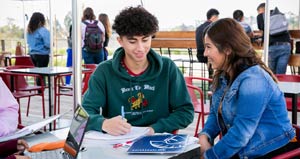
Planning and Pacing
By: Professor Jennifer Hirashiki
Have you ever been in a class or meeting that has felt VERY long? We all have! But hopefully you have also experienced exciting classes that fly by!
This year, I began taking a language class. For the first 10 weeks, I attended the class in a traditional on-site classroom. I enjoyed being able to watch the teaching strategies used, as well as observe the student-centeredness of the class. Recently, the class has moved online and it has been fun to see the school make this transition with their teachers. For so long, I have been the teacher or observer in online classes, not the student. It has been a surprising adjustment! For the most part, the teacher is doing an excellent job of engaging students in the class- using breakout rooms, changing tasks up every few minutes, calling on students, and teaching new content. Despite all of this, I still find myself reaching for my cell phone and scrolling through Instagram. Or I notice that I forgot to shut my work email and got g-chats that need to be answered. But why? I tend to be a very prepared student. I come to class ready to participate, but sometimes the pace can slow down a bit, and I am so very tempted to pick up my phone out of habit. And this is in a very engaging and well-run class!
So let’s switch gears and think about our own classes that we teach. When teaching online, we are in direct competition with everything around the student: roommates, cell phones, pets, windows, snacks, paper, windows, everything! How we plan for and pace our classes can either allow those distractions to win, or help us to compete!

The pace of a class pertains to the speed or perceived speed of the class. Some activities may be done quickly, while others might need more time, however, the pace of the class continues to move and build up effectively. Changing tasks can add excitement and movement to the overall lesson and pace. A few aspects to consider when planning with pace in mind are:
Plan well: Good pacing comes from solid planning and anticipation. All parts of the lesson, presentation, and activities should be reviewed, placed appropriately, and given the appropriate time needs.
Keep the pace up: Planning instruction, tasks, and discussions in 10-minute chunks can help break down activities while keeping the pace up.
Have clear goals in tasks: Write instructions on a slide, create clear deliverables or goals for the work, and check understanding.
Transition smoothly: Plan to build upon parts of a lesson. Move from an instructional teaching piece to a focused discussion. Build upon the introductory discussion into a problem-solving task. Think about how students are prepared to move into different parts of the lesson
Check for understanding: If students get it, move on! Doing formative assessment of the topics throughout the class can help you know if you can move faster or slower.
Include elements of suspense: Keep the students guessing. Kahoots can be a really fun element one week, but even fun activities can become boring if overused. Try out new activities, use student examples, plan for engaging mini projects in class. Keep it varied.

Plan A, B, and C (and D, E, F): Planning with pace in mind means that you might need to plan which activities can move quicker if others take more time. It means you will likely want to have extra activities ready in case you finish early.
Effective pacing takes time and attention. It can help to review your recorded lessons and line them up with your original plan. Make sure to write down your anticipated timing structure for the class. As you reflect upon your pacing, also determine why you made the decisions you made in the moment. What would you do differently next time? How was the pace impacted positively? Negatively? This is a self-observation practice that occurs regularly in educator preparation programs and can be very beneficial to our own teaching practice.






